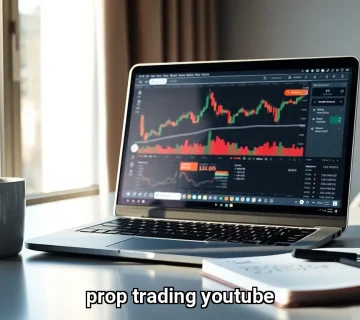In the fast-paced world of finance, traders are constantly exploring various strategies to gain an edge in the market. Among these, the debate of prop trading vs flow trading emerges as a compelling topic, with each strategy offering unique characteristics and advantages. Prop trading, or proprietary trading, involves firms using their own capital to engage in market activities, often leveraging advanced strategies to capitalize on market inefficiencies.
On the other hand, flow trading focuses on executing large volumes of trades based on market orders, typically driven by the flows of institutional clients. Understanding the differences between these two approaches is crucial for any trader looking to enhance their trading strategies. For example, Propx Pro, a proprietary trading firm, blends these methods to refine its market positioning and take advantage of liquidity opportunities while managing risk effectively. This understanding can not only help in making informed decisions but also in navigating the complexities of market behavior, ultimately enhancing trading outcomes over time.
Proprietary trading involves financial institutions using their own capital to make trades, allowing for a high degree of autonomy and the potential for significant returns. On the flip side, flow trading focuses on facilitating transactions between buyers and sellers, with traders aiming to capitalize on the bid-offer spread rather than making directional bets. The contrasting nature of these strategies means that traders must align their approach with their risk tolerance and market understanding. For instance, prop traders may thrive in volatile markets where they can leverage their insights, while flow traders might excel in steady, high-volume environments that allow them to capitalize on frequent trades.
As we delve into these trading styles, we’ll explore their distinct strategies, risk factors, and the environments in which they thrive. Whether you’re a seasoned trader or just starting out, comprehending these nuances can inform your decisions in the dynamic financial landscape. It’s crucial to understand how market conditions affect each trading style and what that means for potential profitability. So, let’s dive deeper into the world of prop trading vs flow trading and uncover what sets them apart. This exploration will not only highlight key differences but also provide practical insights that can be applied in real-world trading scenarios.
Prop Trading vs Flow Trading
The financial markets offer various trading strategies, among which prop trading and flow trading stand out as two distinct approaches. Understanding the nuances of these trading methodologies is crucial for traders and investors looking to navigate the complex landscape of financial trading effectively. This article delves into the characteristics, strategies, and differences between prop trading vs flow trading, providing valuable insights for anyone interested in these trading styles. By comparing these two strategies, we can better understand how they fit into the broader context of financial trading and investment.

Understanding Prop Trading
Prop trading is a trading strategy in which a financial institution, such as a bank, uses its own capital to trade financial instruments. Unlike traditional investment strategies that involve client funds, prop trading is akin to operating an internal hedge fund where traders make investment decisions based on their analyses and insights. Prop traders typically take directional bets on market movements, meaning they speculate on the price movements of assets, aiming to generate returns based on their forecasts. This speculative nature of prop trading allows for potentially high returns, but also introduces significant risks that traders must manage carefully.
One of the key aspects of prop trading is that it attracts some of the most talented traders in the industry. These individuals are often drawn to the autonomy and potential for high returns that prop trading offers. Traders can select the trades they wish to pursue, much like an investor would, allowing them to leverage their expertise in making investment decisions. However, prop trading has faced significant regulatory changes over the years, particularly due to the Volcker Rule, which restricts banks from engaging in proprietary trading.
As a result, many banks have spun out their prop trading desks into independent hedge funds, creating a shift in how prop trading is conducted within the financial ecosystem. This transition has changed the landscape for many traders, presenting both challenges and opportunities as they adapt to new operational frameworks.
Additionally, prop traders operate under the pressure of generating substantial returns, much like hedge fund managers. Their earnings can be influenced by market conditions, individual performance, and the strategies they employ. This high-stakes environment often leads to intense competition among traders, who must continuously refine their strategies to remain successful in the fast-paced world of finance. The challenge of consistently outperforming the market requires not only analytical skills but also emotional resilience and risk management capabilities.
As prop trading continues to evolve, firms like Propx Pro are positioning themselves to provide resources and insights for traders navigating this complex landscape. By offering tools and guidance, these firms aim to empower traders to make informed decisions and adapt effectively to market changes.
Flow Trading Strategies
Flow trading, on the other hand, represents a different approach within the trading realm. In flow trading, banks act as principals, facilitating trades between buyers and sellers. Here, the client decides whether to buy or sell a particular asset, while the trader sets the price and takes the other side of the transaction. The primary objective for flow traders is to profit from the bid-offer spread, which is the difference between the buying and selling prices of a financial instrument. This transactional focus necessitates a keen understanding of market dynamics and the ability to respond quickly to changing conditions.
Flow trading is characterized by its reliance on high volumes of trades, which helps traders maximize their profits through the bid-offer spread. This approach is particularly common in over-the-counter (OTC) markets, where trades do not occur on traditional exchanges. Flow traders must develop strategies to capture trade flows effectively, ensuring that they can manage their risk while capitalizing on the volume of transactions they facilitate. The ability to anticipate market movements and client needs is crucial for flow traders, as it enables them to position themselves advantageously in the market.
Unlike prop traders, flow traders typically do not hold strong opinions about the long-term value of the assets they trade. Their focus is primarily on executing trades and managing risk, rather than making directional bets on market movements. This distinction highlights the operational differences between the two trading styles. For instance, in a bull market, prop traders might outperform flow traders due to their ability to make substantial directional bets, while in a sideways or directionless market, flow traders may have the upper hand by capitalizing on the consistent flow of trades. The contrasting strategies reflect the different skill sets and market approaches required for success in each trading style.
Differences Between Prop Trading and Flow Trading
To clearly delineate the differences between prop trading vs flow trading, it is essential to consider various aspects that define each strategy. These distinctions not only highlight the operational frameworks but also underscore the different risk management techniques employed by traders in each domain.
This table outlines the fundamental distinctions that define prop trading vs flow trading, highlighting how each strategy operates within the financial markets. By understanding these differences, traders can better assess which approach aligns with their objectives and risk tolerance. This knowledge is invaluable as it helps traders to strategize effectively and make informed decisions that can lead to improved trading results.

Benefits of Prop Trading
Prop trading offers several advantages for both traders and firms. One significant benefit is the potential for higher returns, as prop traders can leverage their insights and analyses to make informed investment decisions. Unlike flow traders, who primarily profit from the bid-offer spread, prop traders can achieve substantial gains through successful directional bets, especially in trending markets. This potential for higher returns can be a significant motivator for traders who thrive on challenge and opportunity.
Moreover, prop trading provides traders with a level of independence and autonomy that can be highly appealing. Traders have the freedom to select trades based on their research and market assessments, allowing them to capitalize on opportunities as they arise. This independence often leads to a more dynamic trading environment where traders can quickly adapt to changing market conditions. The capacity to operate independently fosters an entrepreneurial spirit among traders, encouraging innovation and strategic thinking.
Additionally, prop trading can be beneficial for financial institutions seeking to retain top talent. By offering prop trading opportunities, banks can attract and retain skilled traders who might otherwise be drawn to hedge funds or other investment firms. This competitive edge can enhance the bank’s overall trading performance and profitability. The retention of skilled traders is critical in maintaining a bank’s competitive advantage in the market.
However, it’s essential to note that while prop trading presents opportunities for significant rewards, it also comes with inherent risks. Traders must possess the skills and knowledge to navigate the complexities of the markets effectively. Institutions like Propx Pro can provide valuable resources and tools to help traders succeed in this competitive landscape, ensuring they are well-equipped to make informed decisions. By leveraging educational resources and advanced trading tools, traders can enhance their capabilities and improve their chances of success in prop trading.
Flow Trading Techniques
Flow trading requires a different set of skills and strategies compared to prop trading. Successful flow traders must excel at capturing trade flows and managing risk while executing transactions efficiently. One effective technique is to utilize algorithmic trading systems that can process vast amounts of data and execute trades at lightning speeds. These systems can help traders identify patterns in order flows, allowing them to optimize their bid-offer spread and increase profitability. The integration of technology into trading practices is essential for improving efficiency and accuracy in execution.
Another critical aspect of flow trading is maintaining strong relationships with clients. Flow traders need to understand their clients’ needs and preferences to provide tailored services that facilitate successful transactions. This client-centric approach can lead to increased trade volumes and enhanced profitability for both the trader and the financial institution. Building and nurturing these relationships requires excellent communication skills and a deep understanding of client objectives.
Moreover, effective risk management is paramount in flow trading. Traders must continuously monitor market conditions and adjust their strategies to mitigate potential losses. This can involve utilizing various financial instruments, such as options and futures, to hedge against adverse market movements. By employing a robust risk management framework, flow traders can navigate the complexities of the financial markets while maximizing their profitability. The focus on risk management ensures that traders are prepared for market fluctuations and can safeguard their investments.
Conclusion
The comparison of prop trading vs flow trading reveals distinct strategies and approaches within the trading landscape. Both methods offer unique advantages and challenges, catering to different types of traders and market conditions. Understanding these nuances is critical for anyone looking to engage in the financial markets successfully. As firms like Propx Pro continue to evolve and adapt to the changing trading environment, they play a pivotal role in supporting traders and investors in their pursuit of success in prop trading and flow trading strategies. This ongoing evolution in trading practices underscores the importance of staying informed and adapting to market trends, ensuring traders are well-prepared for future challenges and opportunities.




No comment